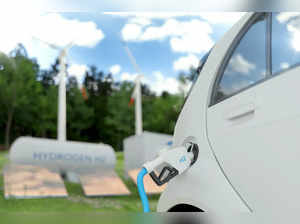
Powered By
Hydrogen, a vital element in water creation, is gaining traction as a fuel source for fuel-cell electric vehicles.
Hydrogen is the most abundant substance in the universe, and a crucial element in the creation of our most precious resource: water.
Initiatives outlined by carmakers last week are breathing new life into plans to use the gas as fuel.
They’re also a reminder that making the world run on hydrogen will need considerable support from diversified businesses such as North Asia ’s storied conglomerates.
The most promising path to exploiting hydrogen is to store the gas in a tank, as you would gasoline, then feed it into a fuel cell where it combines with oxygen to create an electric current, with water as a byproduct.
Put this in a car and you have a fuel-cell electric vehicle.
Recently, industry has turned to green hydrogen, created by running an electric current through water with an electrolyte.
The machines that do this are called electrolyzers, and like battery EVs, they are only truly green if the original electricity source comes from renewables.
Parking an electrolyzer near a wind farm, solar array or hydroelectric dam would be ideal because you can use renewable energy to deliver clean electricity directly to the hydrogen-production facility.
But the gas would still need to be transported to refueling stations, possibly through natural gas pipelines.
The ultimate solution, the one that industry ought to strive for, is on-site extraction, storage and refueling.
Such facilities could be tacked onto existing gas stations, but needn’t be. Since electrolysis equipment only requires water and electricity, there’s more flexibility in placement.
An alternative to electrolysis is to use organic waste by extracting hydrogen from rotting food or sewage.
Right now, few companies have any reason to invest in this infrastructure.
Tesla Inc.’s car-plus-recharging model is the exception to the rule, and shows us that that end-to-end solutions are the best way to kickstart an entirely new transport ecosystem.
Existing oil suppliers and gas-station operators don’t seem keen to push into the fuel-cell era, especially since there’s barely any hydrogen vehicles on the road now. Just 223 were sold in the US in the first quarter, out of 3.8 million vehicles in total.
It’s also a stretch to expect traditional US car companies such as General Motors Co. or Ford Motor Co. to step out of their wheelhouse into the fueling business.
These firms are already struggling to manage their EV rollouts, with battery technology and supply proving major stumbling blocks.
Asian conglomerates may be the answer.
Hyundai Motor Co. , Honda Motor Co. and Toyota Motor Corp.
each showed off hydrogen-power solutions at the Advanced Clean Transportation Expo in California last week.
All three automakers are part of larger business empires — called chaebol in South Korea and keiretsu in Japan.
Outside of their home countries, they are best known for making cars and motorbikes.
But their tentacles extend deep into other areas.
Toyota, for example, has at least 17 companies in its group with affiliates that include a steelmaker, a textiles supplier and a machine tool developer.
South Korea’s Hyundai may be the most diversified.
It encompasses companies that build and service ships, produce electric motors, and even supply robots.
While splits and spinoffs over the years have diluted cross-shareholding and management have been diluted, the chaebol still benefits from a closer relationship among businesses in disparate industries than anything seen in Europe or North America.
It also has a plan.
Hyundai thinks it can leverage its conglomerate advantage to build out the entire fuel-cell supply chain “from hydrogen production and storage to logistics, transport and diverse applications.
” Last year it put 30 of its heavy-duty XCIENT trucks on the road in California to haul freight from ports in Oakland and Richmond.
Building and driving the vehicle is the easy part.
What companies like Hyundai are also attempting to do is create the infrastructure to extract, store and transport hydrogen.
In South Korea, for example, a pilot project turns food waste into the clean gas, which is then stored locally for on-site refueling.
By the end of 2024 Hyundai it expects to have another plant convert sewage into hydrogen.
Honda, which aims to have 40% of its global sales by 2030 come from EVs and fuel-cell vehicles, is also turning to its broad industry reach to make both cars and the fuel.
This month the Japanese company showcased a hydrogen fuel-cell-powered truck similar in size and capacity to Hyundai’s. With battery electric vehicles getting cheaper, and combustion engines still the preferred choice, hydrogen’s window of opportunity is relatively small and closing fast.
If this alternative technology is to get a foothold, it’ll need fully integrated suppliers that stand to profit from every link in the supply chain.
That puts the burden on Asia’s chaebol and keiretsu to bring all their resources to bear if hydrogen is to have a shot of becoming part of our green-energy future.
